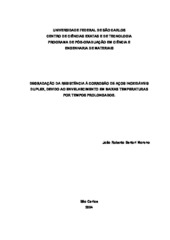Degradação da resistência à corrosão de aços inoxidáveis duplex, devido ao envelhecimento em baixas temperaturas por tempos prolongados.
Abstract
Although duplex stainless steels exhibit good performance in many severe corrosive environments, their corrosion resistance can be hampered by precipitation of chromium (Cr) rich phases during aging heat treatments.
Microstructural changes and corrosion behavior in two alloys with high and low
content of chromium were investigated. Duplex stainless steels samples were
aged at low temperatures (300°C and 400°C) for 3000, 5000 and 7000 hours.
The changes at the microstructure were followed during the annealing time
using an optical microscopy and measurements of phase percentages.
Nanohardness was used in order to identify the phase responsible for the
increasing in the global hardness. Immersion tests in ferric chloride cloreto
férrico (FeCl3.6H2O 10%) and surface analysis by XPS were conducted
intending to quantify the depletion in the corrosion resistance and identify the
oxides presented in the surface oxide layer. G phase precipitation and α phase
due to spinodal decomposition was identified by transmission electron microscopy. It was detected that the micro-structural changes affect the global properties, remarkably the global hardness and the corrosion resistance. TEM
results showed that the Cr rich precipitation occurs manly in the ferritic phase.
Spinodal decomposition and heterogeneous precipitation of G phase were
found to be responsible for degradations of the corrosion properties. The results
also showed a difference between the kinetics of precipitation of the lower Cr
content sample and the higher Cr sample. The phenomena of precipitation and
coalescence of Cr rich phases must be related with the increasing and
decreasing tendencies of hardness, respectively and, inversely, the decreasing
and increasing tendency of the resistance to localized corrosion and corrosion
rates, which were determined by two electrochemical techniques (Tafel
extrapolation and polarization resistance methods) and were compared with the
rates determined by weight-loss measurements.
